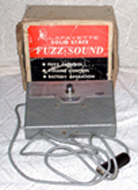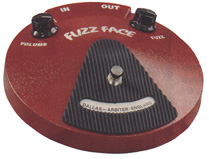Effects, Gimmicks & Gadgets
Starting out all a person needed for equipment was their chosen instrument and that was about it. For the guitar, bass and keyboard player that meant an amplifier also. For the drummer nothing more than the drum kit was necessary. The guitar, bass and keyboard player had a limited palette to chose from as far as shaping the sound of their instrument. Most amps had bass and treble controls with some amps having tremolo and reverb. Tremolo produced a continuous change in level from softer to louder. It was sometimes erroneously called vibrato depending on the amp manufacturer. The one exception I know of were the amps made by Magnatone. They made an amp with true vibrato–a wavering of pitch instead of volume like tremelo. Reverb created a cavernous sound putting the instrument into a larger sounding space. The surf music instrumentals used these two “effects” quite a bit. These were the only choices for the musicians at the start. At least until something new came along–that something new being effects pedals.
These foot pedals–or stomp boxes as they later became known–were mostly directed towards guitarists with a few devices geared for bass and keyboards. As is even done today, the player plugged his instrument into the pedal and plugged the pedal into his/her amp. This allowed the pedal to alter the instruments sound in, hopefully, the desired way. Most boxes had controls to change various aspects about the effect and a foot switch to turn the effect on or bypass the effect completely. The first effect to really take hold was the fuzz box or distortion pedal.
If you’ve heard the song “(I Can’t Get No) Satisfaction” by the Rolling Stones you have heard one of the first uses on a rock recording of the fuzz box. A fuzz box was/is a device that alters the guitars waveforms by distorting–or changing–the harmonic content of those waveforms. To put it another way, the fuzz box chopped off the tops of the guitars outputted waveforms giving them a flat top hair cut. Fuzzrite, Super Fuzz, Harmonic Energizer, Fuzz Face, Buzz Box, Big Muff and Maestro Fuzz Tone are all names for the roughly the same thing by different manufacturers. For the Stones’ tune Keith Richards used the Gibson Maestro Fuzz Tone to get the sound on his guitar. A band wanting to cover this particular song needed this effect to do the song justice. Needless to say the Maestro units sold like hit 45s and other manufacturers started cranking them out too.
You may be wondering why a guitar player would want to “distort” their guitars sound. The story goes that players like Richards were wanting to emulate the guitar sounds they heard on old recordings of the blues players they loved. Poking holes in speaker cones or otherwise damaging the speaker was one approach. Unfortunately, when a player wanted a clean tone, they would have to use another amp. Turning up the amps volume was another approach to get distortion, but often not practical due to the loudness of the amp ruining the overall balance of the band. Some way to have the distortion when wanted without physically destroying speakers was searched for by players. The Gibson unit was one of the first commercially available and it–along with other similar boxes–changed the sound of rock guitar forever.
These foot pedals–or stomp boxes as they later became known–were mostly directed towards guitarists with a few devices geared for bass and keyboards. As is even done today, the player plugged his instrument into the pedal and plugged the pedal into his/her amp. This allowed the pedal to alter the instruments sound in, hopefully, the desired way. Most boxes had controls to change various aspects about the effect and a foot switch to turn the effect on or bypass the effect completely. The first effect to really take hold was the fuzz box or distortion pedal.
If you’ve heard the song “(I Can’t Get No) Satisfaction” by the Rolling Stones you have heard one of the first uses on a rock recording of the fuzz box. A fuzz box was/is a device that alters the guitars waveforms by distorting–or changing–the harmonic content of those waveforms. To put it another way, the fuzz box chopped off the tops of the guitars outputted waveforms giving them a flat top hair cut. Fuzzrite, Super Fuzz, Harmonic Energizer, Fuzz Face, Buzz Box, Big Muff and Maestro Fuzz Tone are all names for the roughly the same thing by different manufacturers. For the Stones’ tune Keith Richards used the Gibson Maestro Fuzz Tone to get the sound on his guitar. A band wanting to cover this particular song needed this effect to do the song justice. Needless to say the Maestro units sold like hit 45s and other manufacturers started cranking them out too.
You may be wondering why a guitar player would want to “distort” their guitars sound. The story goes that players like Richards were wanting to emulate the guitar sounds they heard on old recordings of the blues players they loved. Poking holes in speaker cones or otherwise damaging the speaker was one approach. Unfortunately, when a player wanted a clean tone, they would have to use another amp. Turning up the amps volume was another approach to get distortion, but often not practical due to the loudness of the amp ruining the overall balance of the band. Some way to have the distortion when wanted without physically destroying speakers was searched for by players. The Gibson unit was one of the first commercially available and it–along with other similar boxes–changed the sound of rock guitar forever.
I never had the Gibson fuzz. Being low on cash I bought what I thought was a good fuzz–a unit from Lafayette Radio Electronics for around $15, It had the cord to the guitar hard wired to the case instead of an input jack like most units. For power it used a AA battery instead of the usual 9 volt battery used in many other fuzz boxes. It sounded good on a fresh battery–similar to natural amp distortion–but the battery did not last long. Noticing that other fuzz boxes used 9 volt batteries instead of the 1.5 volt AA battery, I figured this was important for whatever reason. I decided I should get one that used a 9 volt for power and back to the Lafayette catalog I went.
There were many other considerations coming to bear when I finally made the decision to purchase a Univox Super Fuzz from Lafayette for around $40. The product description in the catalog claimed the box was able to mimic a saxophone or brass instrument and “at the flick of a switch” sound like a sitar. The aforementioned switch, which was mounted on the side of the box along with the controls–making it nearly impossible to switch while playing–did change the sound rather dramatically, but neither a sax nor a sitar was in evidence. The one sound had a good bite to it while the other was a warmer, less edgy distortion.
On the way to the Univox pedal I had the opportunity to fool around with a Fuzz Face–which years later I saw Jimi Hendrix using in the movie “Rainbow Bridge”. (Why didn’t I buy that thing?!?) Klocksiem’s, our local piano & organ store in Ogden, had one in stock. It was unlike any fuzz box I had seen up to that time. It was round! It had a silver finish and was about 8 in. in diameter with a volume and a fuzz amount control. The area around the foot switch had a nonslip ribbed rubber surface. It looked a lot like a low profile mic stand base. Mike–our lead guitar player at the time–asked if he could try the pedal out at home and the store loaned it to him. His real intentions were to use it at the sophomore class dance we were playing for that evening.
The Fuzz Face had a unique sound. As the signal from the guitar decayed the fuzz would break up more making less of a smooth, run together fuzz sound. In fact, the sound of the fuzz guitar on “Spirit in the Sky” by Norman Greenbaum sounds like a Fuzz Face with this particular facet of the sound showing up on the guitar after the instrumental bridge of the song. (Mr. Greenbaum stated in an interview that the fuzz used was built into his guitar by a friend. It was perhaps a circuit adapted from what was available at the time.) The Fuzz Face was the only box I ever heard that could do that.
The Fuzz Face had a unique sound. As the signal from the guitar decayed the fuzz would break up more making less of a smooth, run together fuzz sound. In fact, the sound of the fuzz guitar on “Spirit in the Sky” by Norman Greenbaum sounds like a Fuzz Face with this particular facet of the sound showing up on the guitar after the instrumental bridge of the song. (Mr. Greenbaum stated in an interview that the fuzz used was built into his guitar by a friend. It was perhaps a circuit adapted from what was available at the time.) The Fuzz Face was the only box I ever heard that could do that.
Speaking of Jimi Hendrix, Electro Harmonix touted their Big Muff fuzz box as giving the player the “Electric Lady” sound of Jimi Hendrix. The Big Muff had a unique sound and good sustain. The distortion made the guitar sound rather compressed–or squished–and reinforced the higher harmonics of the notes played. If a player could get the right note, he/she could send the sound into feedback without having the usual loud volume necessary to do so naturally. Many times as the note sustained out the fundamental would melt away leaving the harmonic dominant until the player changed notes. To hear an example of this listen to “Aren't You Glad” from Spirit’s “The Family That Plays Together” album. Randy California gets a similar sound on his guitar in this tune, although he was using a Jordan Electronics Boss Tone fuzz.

